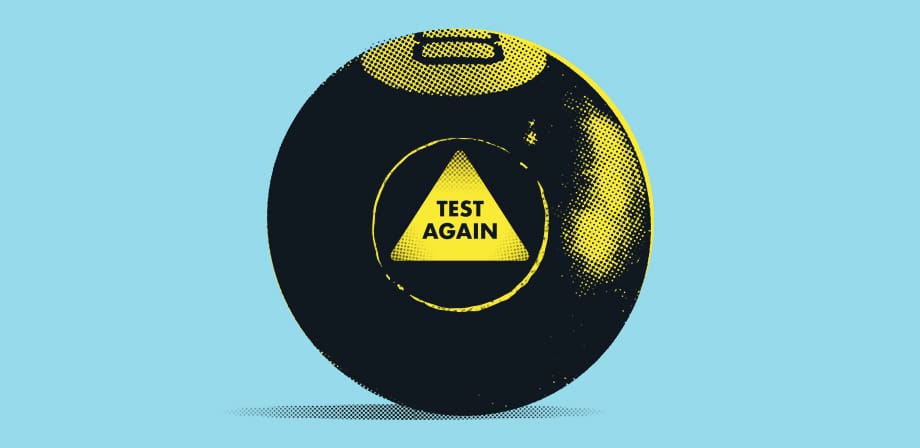If an agency and client share one common goal at the outset of their collaboration, it’s the pursuit of innovation. For brands, an eye-catching product launch establishes buzz and sets the tone for successful sales figures. For agencies, a groundbreaking campaign allows us to flex our skills and further the reach of our creativity.
But within the drive for innovation comes a measure of risk. Big ideas can be scary, and you only have one chance to capture your audience’s attention for the reveal of a new product. Given those kinds of stakes, many marketing managers will shut down innovative, forward-thinking ideas for more proven tactics.
But what if the tactics behind a groundbreaking idea can be proven? If your agency conducts iterative testing around a prospective campaign, you can mitigate the risk level involved. Through breaking down an idea into its attendant parts for examination, boundary-pushing ideas either grow stronger or are safely changed before a public launch. That way, when you present an important idea to your managers, you can be far more confident in the end result. In the process, your big idea won’t seem so risky after all.
Think of it as how comedians approach an upcoming Netflix special. With only one chance to impress an audience of that size, do they deliver a joke for the first time at the taping? Or do they test their ideas in front of friends and progressively larger audiences until the material is sharp? Your big ideas deserve the same level of testing before standing them up before the world.
An iterative testing approach sets a foundation for innovation
Before debuting any campaign, consistent message testing is the surest way to mitigate uncertainty around an idea. But an iterative approach to evaluating your innovative idea demands a different framework from ongoing testing.
Through iterative testing, you test these risky approaches by breaking them into pieces to ensure they’re valid. Once testing has delivered a set of proof points behind an idea’s components, you can present your supposedly crazy promotional idea with the data to support its success.
You should evaluate a campaign idea on three fronts: Desirability, viability, and feasibility. Desirability simply comes down to understanding what your audience wants. Does the target customer want to see your brand or product in this way? User testing and interviews provide valuable insights into customer expectations.
Feasibility refers more to the technical demands of a given idea: Can your organization build or support this idea? Do you have the resources to see it through to completion once the agency’s role is complete? For example, until you perform a feasibility study, you will have no idea whether a virtual reality component is a viable addition to a given campaign.
Viability considerations primarily focus on your brand’s bottom line. Will your campaign idea drive sales? A campaign that costs $5 million to produce that at best will generate only $4 million in revenue is obviously not viable. Through testing, you can find out whether your idea makes business sense as well.
By establishing this kind of framework from the beginning, you can be strategic about your testing approach. However, as much as iterative testing may sound repetitive, you have to build upon your results with each successive version. Each test generates valuable data that informs the next design, which is then tested again.
Manage risk by maintaining a foothold in proven data
In iterative testing, you must stay focused on what you’ve learned about the desirability, viability, and feasibility of a big idea. With this grounded approach to evaluating an innovative campaign, your approach to risk management is not unlike that of a rock climber.
Rock climbers are taught to retain three points of contact that allow you to lunge for the next foothold. Too often, marketers will reach in all directions in establishing an innovative idea without staying grounded in a core principle. You want to establish a steady foundation based on a tested conclusion before reaching for the next big thing.

Any iterative testing strengthens your campaign idea
Early testing is designed to find the cracks and flaws in your big idea. While it can be daunting to expose your idea to this kind of scrutiny, your ability to discover these flaws at the outset is far more preferable in the early, low-stakes stages. Once flaws in an innovative concept are found, they're far easier to repair before the fate of a campaign is riding on the idea.
Testing doesn’t have to be difficult or intimidating to undertake. User surveys and interviews provide a solid, data-gathering foundation in the early stages, and your approach expands as a prototype takes shape. Contextual interviews determine how users interact with your designs, and digital tools have streamlined user testing. Websites such as UsabilityHub allow you to quickly generate five-second and first-click tests that drive further refinement. No matter how shallow, each successive round of iterative testing is informative and provides value.
Mitigating the risk in innovation requires consistent evaluation
Sometimes, internal marketing teams struggle because they see their great ideas repeatedly shot down when presented to their managers. Consequently, producers often find themselves ready to try innovative, unexpected approaches but they are discouraged to present them. After so much rejection, they don't see their brand as open to forward-thinking approaches.
You can manage these risks through breaking down ideas to their components and testing the response. By evaluating, validating, and refining each part of an idea, you gather the needed proof that it works. Then, what sounded like a crazy idea for your company isn’t so crazy because your agency implemented iterative testing. By standing on the shoulders of each successive improvement, the big reveal of your new campaign isn’t so scary.


